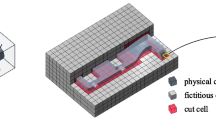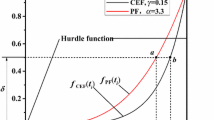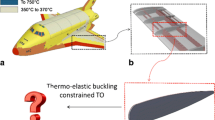Abstract
This paper investigates topology design optimization for maximizing critical buckling loads of thin-walled structures using a moving iso-surface threshold (MIST) method. Formulation for maximizing linear buckling loads with additional constraints on load-path continuity and lower bound of eigenvalue is firstly presented. New physical response functions are proposed and expressed in terms of the strain energy densities determined in the two-steps of finite element buckling analysis. A novel approach by introducing a connectivity coefficient is developed to ensure continuity of effective load-path in optimum topology. The lower bound of eigenvalue is defined to eliminate spurious localized buckling modes. The MIST algorithm and its interfaces with commercial finite element (FE) software are given in detail. Numerical results are presented for topology optimization of plate-like structures to maximize critical buckling forces or displacements considering in-plane and out-of-plane buckling respectively. The FE analyses of the re-meshed final solid topologies with and without void material reveal that the presence of the void material has a significant effect on the out-of-plane buckling loads and a minor influence on the in-plane buckling loads.















Similar content being viewed by others
Abbreviations
- [B]:
-
Strain–displacement matrix
- [D]:
-
Elastic constant matrix
- [K]:
-
Structural stiffness matrix
- [K σ ]:
-
Structural geometric stiffness matrix
- [k]:
-
Elemental stiffness matrix
- [k σ ]:
-
Elemental geometric stiffness matrix
- [N]:
-
Shape function matrix
- [u]:
-
Vector of physical displacements
- [F]:
-
Vector denoting external loadings
- {Y}:
-
Eigenvector
- Φ:
-
Physical response function
- Ω:
-
Design domain
- λ 1 :
-
The 1st order eigenvalue
- λ min :
-
The lower bound of eigenvalue
- k 1 :
-
Generalized stiffness for the 1st order mode
- k σ1 :
-
Generalized geometric stiffness for mode 1
- E s :
-
Total strain energy in static analysis
- E sd :
-
Strain energy density in static analysis
- E λ :
-
Total strain energy for the 1st order buckling mode
- E λd :
-
Strain energy density for buckling mode 1
- N e :
-
Total element number
- N n :
-
Total node number
- t:
-
The level or threshold value of the iso-surface S
- V e :
-
Element volume with solid materials
- V 0 :
-
Structure volume with solid materials
- V f :
-
Volume fraction
- x e :
-
Weighting factor ranging from 0 to 1
- E :
-
Young’s modulus
- ν :
-
Poisson’s ratio
- e:
-
Subscript for the eth element
References
Bendsoe MP, Kikuchi N (1988) Generating optimal topologies in structural design using a homogenization method. Comput Methods Appl Mech Eng 71(2):197–224
Bendsoe MP, Sigmund O (2003) Topology Optimization: Theory, Methods and Applications. Springer, Berlin
Bendsøe MP, Triantafyllidis N (1990) Scale effects in the optimal design of a microstructured medium against buckling. Int J Solids Struct 26(7):725–741
Ben-Tal A, Jarre F, Kočvara M, Nemirovski A, Zowe J (2000) Optimal design of trusses under a nonconvex global buckling constraint. Optim Eng 1(2):189–213
Browne PA, Budd C, Gould NIM, Kim HA, Scott JA (2012) A fast method for binary programming using first-order derivatives, with application to topology optimization with buckling constraints. Int J Numer Methods Eng 92(12):1026–1043
Bruyneel M, Colson B, Remouchamps A (2008) Discussion on some convergence problems in buckling optimisation. Struct Multidiscip Optim 35(2):181–186
Cheng K-T, Olhoff N (1981) An investigation concerning optimal design of solid elastic plates. Int J Solids Struct 17(3):305–323
Cook RD, Malkus DS, Plesha ME (2001) Concepts and applications of finite element analysis, 4th edn. Wiley, New York, c2001
Du J, Olhoff N (2007) Topological design of freely vibrating continuum structures for maximum values of simple and multiple eigenfrequencies and frequency gaps. Struct Multidiscip Optim 34(2):91–110
Eldred MS, Venkayya VB, Anderson WJ (1995) Mode tracking issues in structural optimization. AIAA J 33(10):1926–1933
Kasaiezadeh, A., Khajepour, A. and Jahed, H. (2010). Using level set method in order to design structures against buckling. Proceedings of the ASME Design Engineering Technical Conference
Lindgaard E, Dahl J (2013) On compliance and buckling objective functions in topology optimization of snap-through problems. Struct Multidiscip Optim 47(3):409–421
Lund E (2009) Buckling topology optimization of laminated multi-material composite shell structures. Compos Struct 91(2):158–167
Ma Z-D, Kikuchi N, Cheng H-C (1995) Topological design for vibrating structures. Comput Methods Appl Mech Eng 121(1–4):259–280
Manickarajah D, Xie YM, Steven GP (1998) An evolutionary method for optimization of plate buckling resistance. Finite Elem Anal Des 29(3–4):205–230
Manickarajah D, Xie YM, Steven GP (2000) Optimisation of columns and frames against buckling. Comput Struct 75(1):45–54
Mateus HC, Soares CMM, Soares CAM (1997) Buckling sensitivity analysis and optimal design of thin laminated structures. Comput Struct 64(1–4):461–472
MSC.Software (2011). MD Nastran 2011 & MSC Nastran 2011 Dynamic Analysis User’s Guide. Santa Ana, CA 92707, USA., MSC.Software Corporation
Neves MM, Rodrigues H, Guedes JM (1995) Generalized topology design of structures with a buckling load criterion. Struct Optim 10(2):71–78
Neves MM, Sigmund O, Bendsøe MP (2002) Topology optimization of periodic microstructures with a penalization of highly localized buckling modes. Int J Numer Methods Eng 54(6):809–834
Niu B, Yan J, Cheng G (2009) Optimum structure with homogeneous optimum cellular material for maximum fundamental frequency. Struct Multidiscip Optim 39(2):115–132
Pedersen NL (2000) Maximization of eigenvalues using topology optimization. Struct Multidiscip Optim 20(1):2–11
Pedersen NL, Nielsen AK (2003) Optimization of practical trusses with constraints on eigenfrequencies, displacements, stresses, and buckling. Struct Multidiscip Optim 25(5–6):436–445
Querin OM, Steven GP, Xie YM (1998) Evolutionary structural optimisation (ESO) using a bidirectional algorithm. Eng Comput (Swansea, Wales) 15(8):1031–1048
Rahmatalla S, Swan CC (2003) Continuum topology optimization of buckling-sensitive structures. AIAA J 41(6):1180–1189
Rong JH, Xie YM, Yang XY (2001) An improved method for evolutionary structural optimisation against buckling. Comput Struct 79(3):253–263
Rozvany GIN (2009) A critical review of established methods of structural topology optimization. Struct Multidiscip Optim 37(3):217–237
Rozvany GIN, Zhou M, Birker T (1992) Generalized shape optimization without homogenization. Struct Optim 4(3–4):250–252
Sekimoto T, Noguchi H (2001) Homologous topology optimization in large displacement and buckling problems. JSME Int J A Solid Mech Mater Eng 44(4):616–622
Sethian JA, Wiegmann A (2000) Structural boundary design via level Set and immersed interface methods. J Comput Phys 163(2):489–528
Sigmund O, Petersson J (1998) Numerical instabilities in topology optimization: a survey on procedures dealing with checkerboards, mesh-dependencies and local minima. Struct Optim 16(1):68–75
Tenek HL, Hagiwara I (1994) “Eigenfrequency maximization of plates by optimization of topology using homogenization and mathematical programming”. JSME Int J C Dyn Control Robot Des Manuf 37(4):667–677
Tong LY, Lin JZ (2011) Structural topology optimization with implicit design variable-optimality and algorithm. Finite Elem Anal Des 47(8):922–932
Vasista S, Tong LY (2012) Design and testing of pressurized cellular planar morphing structures. AIAA J 50(6):1328–1338
Wang MY, Wang XM, Guo DM (2003) A level set method for structural topology optimization. Comput Methods Appl Mech Eng 192(1–2):227–246
Xie YM, Steven GP (1993) A simple evolutionary procedure for structural optimization. Comput Struct 49(5):885–896
Yamada T, Izui K, Nishiwaki S, Takezawa A (2010) A topology optimization method based on the level set method incorporating a fictitious interface energy. Comput Methods Appl Mech Eng 199(45–48):2876–2891
Zhao Q, Ding Y, Jin H (2011) A layout optimization method of composite wing structures based on carrying efficiency criterion. Chin J Aeronaut 24(4):425–433
Zhou M (2004) Topology optimization for shell structures with linear buckling responses. Computational Mechanics, WCCM VI, Beijing
Zhou M, Rozvany GIN (1991) The COC algorithm, part II: topological, geometrical and generalized shape optimization. Comput Methods Appl Mech Eng 89(1–3):309–336
Acknowledgments
The authors are grateful for the support of the Australian Research Council via Discovery-Project Grants (DP110104123 and DP140104408).
Author information
Authors and Affiliations
Corresponding author
Appendices
Appendix A. Calculation of strain energy density and construction of the Φ function
In MIST, the Φ function is constructed by its nodal values, which can be extracted from elemental data. The strain energy density in static stress analysis and that in buckling analysis for mode 1 in the e th element can be calculated by:
where {σ e s } and {ε e s } are the stress and strain in the static analysis; \( \left\{{\boldsymbol{\upsigma}}_{\lambda_{\mathbf{1}}}^{\mathbf{e}}\right\} \) and \( \left\{{\boldsymbol{\upvarepsilon}}_{\lambda_{\mathbf{1}}}^{\mathbf{e}}\right\} \) are those in buckling analysis for the 1st order mode; [B] and [D] are the strain–displacement and elastic constant matrices. The strain energy densities at Gaussian points can be determined for element by element by using (A1) and (A2), and then the Φ function surface can be constructed by evaluating their nodal values through averaging the values at the surrounding Gaussian points as in (Tong and Lin 2011; Vasista and Tong 2012) or using other stress or strain recovery techniques.
As an alternative approach, the element-based average strain energy densities for the e th element at static and buckling analyses can be calculated by:
where [k e ] is the stiffness matrix of the e th element. The nodal values of strain energy densities can be found by using 2nd order polynomial interpolation over adjacent three elements. This alternative approach may be handy as some commercial FEA software can output data of strain energy densities at element centres or even at element nodes. Therefore, the Φ function surface is formed by connecting its nodal values and it will be further normalized to a range [−1, 1] to avoid dealing with too small or large numerals in the present computations.
Appendix B. Interfaces of MIST with MSC NASTRAN
2.1 B.1 Create FEA input file
Data input file ‘eigen.bdf for NASTRAN is created in the 1st iteration and then modified by using updated element weight factors in the subsequent iterations. In the created/modified input file, the following statements should be included in Sections ‘Global Case Control’ and ‘Bulk Data’:
Global Case Control:
Subcase 1
TITLE = static analysis
ESE(THRESH = 1.E-32) = ALL
Subcase 2
TITLE = buckling analysis
ESE(THRESH = 1.E-96) = ALL
Bulk Data:
EIGRL,1, 1.E-3,,10, 0,,,MAX
ESE statement used to directly extract elemental strain energies and their densities at each element centre. Very small threshold values are set so that the energy densities at all elements can be output. In the bulk data entry EIGRL, 1.0E-3 or the reasonable positive value must be entered in the 3rd column for satisfying the constraint of 0 < λ min < λ 1 to eliminate the spurious local buckling mode.
2.2 B.2 Read strain energy densities from the FEA output file
The following function can be used to read the strain energy density at element center in static analysis the 1st order mode from NASTRAN output file ‘eigen.f06’.
fid = fopen(‘eigen.f06’,‘r’);
Block = 1;
while (~feof(fid))
InputTextS = textscan(fid,‘%s’,1,‘delimiter’,‘\n’);
SS = cell2mat(InputTextS{1,1});
SS1 = ‘SUBCASE 1 * TOTAL ENERGY OF ALL ELEMENTS IN SET’;
SS2 = ‘E I G E N V A L U E A N A L Y S I S S U M M A R Y (READ ODULE)’;
TFS1 = strncmp(SS,SS1,30);
TFS2 = strncmp(SS,SS2,30);
if TFS1
InputTextS = textscan(fid,‘%s’,2,‘delimiter’,‘\n’);
HeaderLines{Block,1} = InputTextS{1};
NumCols = 4;
FormatString = repmat(‘%f’,1,NumCols);
InputTextS = textscan(fid,FormatString,46);
Data{Block,:} = cell2mat(InputTextS);
[NumRows,NumCols] = size(Data{Block});
Block = Block + 1;
elseif TFS2
break;
end
end
ESES0 = cell2mat(Data);
ESES0(:,1:3) = [];
ESES(1:Ne, :) = ESES0(1:Ne);
fclose(fid);
The following function can be used to read the strain energy density at element center in buckling analysis for the 1st order mode from NASTRAN output file ‘eigen.f06’.
fid = fopen(‘eigen.f06’,‘r’);
Block = 1;
while (~feof(fid))
InputText = textscan(fid,‘%s’,1,‘delimiter’,‘\n’);
S = cell2mat(InputText{1,1});
S1 = ‘MODE 1 * TOTAL ENERGY OF ALL ELEMENTS IN SET’;
S2 = ‘MODE 2 * TOTAL ENERGY OF ALL ELEMENTS IN SET’;
TF1 = strncmp(S,S1,30);
TF2 = strncmp(S,S2,30);
if TF1
InputText = textscan(fid,‘%s’,2,‘delimiter’,‘\n’);
HeaderLines{Block,1} = InputText{1};
NumCols = 4;
FormatString = repmat(‘%f’,1,NumCols);
InputText = textscan(fid,FormatString,45);
Data{Block,:} = cell2mat(InputText);
[NumRows,NumCols] = size(Data{Block});
Block = Block + 1;
elseif TF2
break;
end
end
ESEG = cell2mat(Data);
ESEG(:,1:3) = [];
fclose(fid);
Rights and permissions
About this article
Cite this article
Luo, Q., Tong, L. Structural topology optimization for maximum linear buckling loads by using a moving iso-surface threshold method. Struct Multidisc Optim 52, 71–90 (2015). https://doi.org/10.1007/s00158-015-1286-0
Received:
Revised:
Accepted:
Published:
Issue Date:
DOI: https://doi.org/10.1007/s00158-015-1286-0




